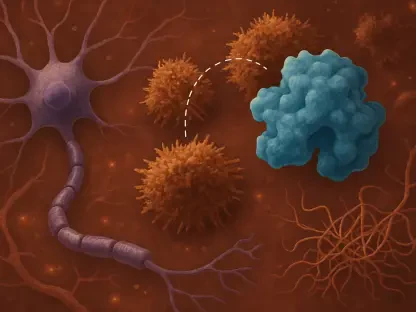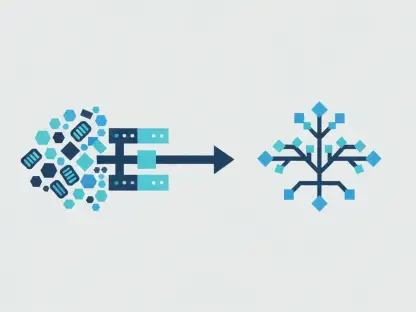The creation and development of high-performance artificial neurons have marked a significant milestone in the field of advanced perception systems. This breakthrough, achieved through collaboration between Northwestern University and Georgia Tech, has led to the development of a novel high-performance organic electrochemical neuron. The key innovation lies in the neuron’s ability to fire within the frequency range of human neurons, overcoming a significant limitation of previous artificial neural circuits. By achieving this unprecedented performance, the development represents a substantial step forward in the effort to bridge the gap between biological and technological systems. This progress is critical as it holds considerable potential for the enhancement of robotics and other intelligent systems that have long faced limitations due to inadequate sensory capabilities.
Overcoming Limitations of Traditional Artificial Neural Circuits
Artificial neural circuits have historically struggled to replicate the adaptive and responsive nature of human sensory systems, primarily due to limitations in their firing frequency range. Traditional artificial neural circuits could only operate within a narrow frequency band, which significantly hindered their ability to capture the complexity and dynamics inherent in human neural responses. This new study, however, presents an organic electrochemical neuron that demonstrates a firing frequency modulation range 50 times broader than existing models. This remarkable advancement not only brings artificial neurons closer to mimicking their biological counterparts but also enhances the capabilities of artificial perception systems exponentially.
The significance of this breakthrough cannot be overstated. Firstly, it represents a critical step toward bridging the gap between biological and technological systems, enabling artificial neurons to perform in ways once thought exclusive to living organisms. Secondly, the broader frequency range and increased performance hold enormous potential for the development of more advanced and sensitive robotics and intelligent systems. These enhanced systems, unburdened by the previous constraints of narrow frequency bands, can respond to a wider array of stimuli, thus becoming more efficient and effective in real-world applications. This leap in technology ultimately paves the way for the creation of machines that can better understand and interact with their environments.
Integration with Tactile Perception Systems
The next significant step in this research was integrating these high-performance artificial neurons into a complete tactile perception system. By combining artificial neurons with artificial touch receptors and synapses, the researchers were able to create a system capable of processing real-time tactile signals in a manner reminiscent of human sensory processing. The study’s findings, published in the Proceedings of the National Academy of Sciences (PNAS), detail the sophisticated creation of this novel artificial neuron and its successful integration into a comprehensive tactile perception system.
This integrated system is capable of encoding tactile stimuli into spiking neuronal signals, which can then be translated into post-synaptic responses. The research showcases a remarkable synergy between organic synthesis, circuit design and fabrication, and system integration. This collaboration among multiple disciplines and departments highlights the innovative approach taken by the research team. The success of the integrated tactile perception system is a testament to the power of interdisciplinary efforts in overcoming scientific challenges. This breakthrough brings us closer to replicating the complex and nuanced sensory processing found in human beings.
Challenges and Future Directions
Despite the striking advancements, the researchers acknowledge that significant challenges remain in mimicking the human brain’s vast network of neurons. One primary focus for future models is to further reduce the size of the devices to create even more efficient perception systems. By miniaturizing these devices, they aim to replicate human sensory systems in both complexity and efficiency entirely. This quest signifies the ongoing commitment to achieving a more profound understanding and imitation of biological sensory systems.
The larger trend in this research reflects a growing interest and progress in the field of organic electronics and neuromorphic engineering. Advanced materials and novel design strategies are crucial in this pursuit. The researchers at Northwestern and Georgia Tech have demonstrated the potential to overcome long-standing barriers in artificial neural circuit performance by leveraging these innovations. This work not only advances the technical capabilities of artificial neural circuits but also sets a precedent for future research in the field. As the research progresses, the goal becomes clear: creating intelligent systems that can process and respond to sensory information in ways that mirror human experiences.
Interdisciplinary Collaboration and Innovation
This achievement underscores the importance of interdisciplinary collaboration in driving innovation and addressing complex scientific challenges. The study, led by first author Yao Yao and corresponding author Tobin J. Marks from Northwestern, along with co-corresponding author Antonio Facchetti from Georgia Tech, highlights significant progress in developing neuromorphic systems. These leaders in their respective fields—Marks, a renowned figure in various scientific disciplines, and Facchetti, a leading expert in materials science—together addressed the critical limitations of existing artificial neural circuits.
The artificial neuron developed in this study operates within a frequency range more aligned with human neurons, offering a much broader range of firing frequencies than previously possible. This detailed collaboration brought together expertise in organic synthesis, electronic device fabrication, and system integration. The convergence of these skills and insights led to creating a device with exceptional neuronal characteristics, essential for developing efficient and scalable perception systems. It is a potent example of how interdisciplinary collaboration can result in innovative solutions to long-standing scientific challenges.
Financial Support and Global Interest
Financial support for this research came from multiple prestigious sources, illustrating the broad interest and potential impact of these developments. Funding came from the Air Force Office of Scientific Research, the Northwestern University Materials Research Science and Engineering Center (MRSEC), Flexterra Corporation, the National Science Fund for Distinguished Young Scholars of China, and the National Natural Science Foundation of China. The diverse funding sources underscore the global recognition of the importance and potential of this research, highlighting the international collaboration and interest in advancing this technology.
The key takeaway from synthesizing the information is clear: the collaboration between Northwestern University and Georgia Tech led to significant advancements in organic electrochemical neurons. These new artificial neurons not only mimic the firing characteristics of human neurons but also operate within a much broader frequency range, which enables more complex and dynamic sensory processing. This research collaboration has successfully addressed one of the most formidable challenges in the field, propelling the technology forward and setting the stage for future innovations.
Potential Applications and Future Prospects
The next major step in this research was incorporating these advanced artificial neurons into a fully functional tactile perception system. By merging artificial neurons with synthetic touch receptors and synapses, the researchers successfully crafted a system capable of processing real-time tactile signals in a manner similar to human sensory processing. Detailed in the Proceedings of the National Academy of Sciences (PNAS), the study highlights the sophisticated development of this groundbreaking artificial neuron and its seamless integration into a comprehensive tactile perception system.
This integrated system can encode tactile stimuli into spiking neuronal signals, which are then translated into post-synaptic responses. The research highlights an impressive blend of organic synthesis, circuit design, fabrication, and system integration. This collaboration among various disciplines and departments underscores the innovative approach of the research team. The success of this integrated tactile perception system exemplifies the power of interdisciplinary efforts in overcoming scientific challenges, bringing us closer to replicating the complex sensory processing found in humans.









